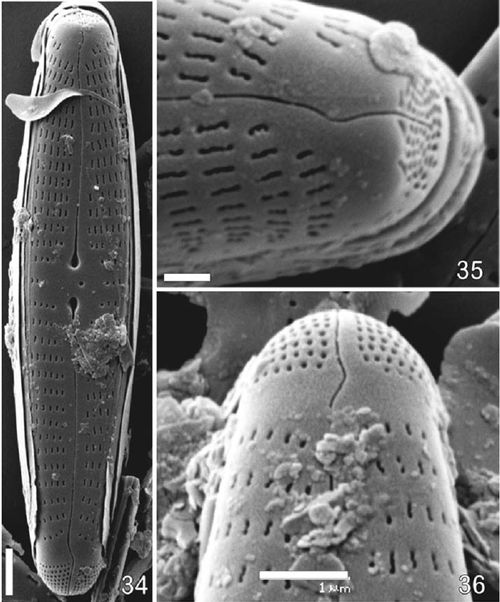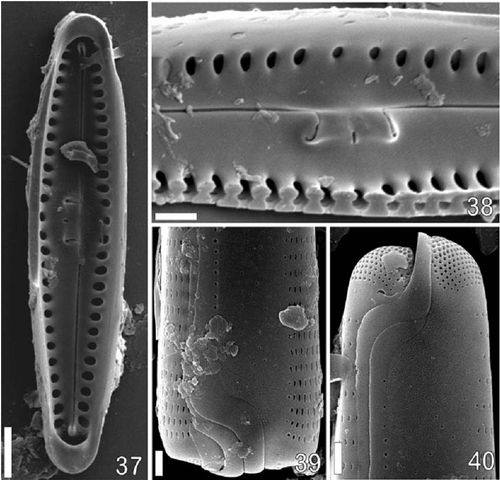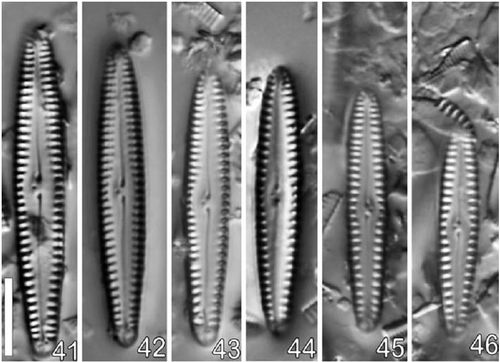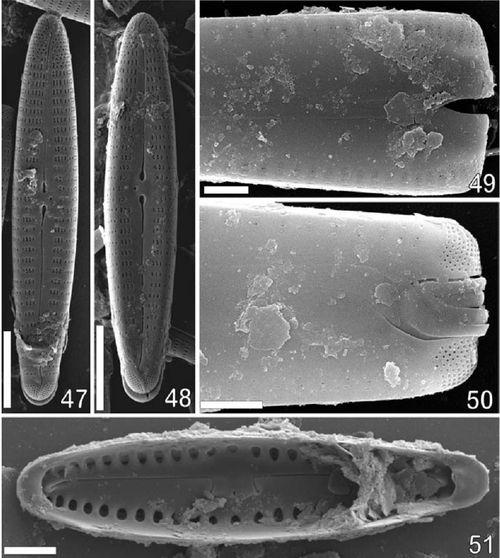|
B. Karthick 1, J.P. Kociolek 2*, M.K. Mahesh 3 and T. V. Ramachandra 1
1 Energy & Wetlands Research Group, Centre for Ecological Sciences, Indian Institute of Science, Bangalore – 560 012, India 2 Museum of Natural History and Department of Ecology and Evolutionary Biology, University of Colorado, Boulder, CO, USA 3 Department of Botany, Yuvaraja’s College, University of Mysore, Mysore - 570 005, India *Corresponding author, email: patrick.kociolek@colorado.edu RESULTSGomphonema gandhii Karthick & Kociolek, sp. nov. Figs 2–19 DESCRIPTIO: Valvae lineares ad lineares-lanceolatae clavatae apicibus rotundatis ad anguste-rotundatis ad fere acuminatae capitolo-polo. Area apicalis porellorum distincta ad baso-polo. Frustula aspectu cincturae cuneata. Striae continuae circa capitulum-polum. Longitudo 19–51 µm. Latitudo 3–7 µm. Area axialis lata linearis-lanceolata. Area centralis indistincta. Raphe lateralis undulata. Extrema proximales externi raphis dilatatae. Externum orificium stigmatis rotundatis. Striae punctatae leviter radiatae ad parallelae, 9–11/10 µm. Septa et pseudosepta prasentia ad polos. DESCRIPTION: Valves linear- to linear-lanceolate-clavate, with apices rounded to narrowly-rounded to nearly acuminate at the headpole. Apical pore field distinct at the footpole. Frustules cuneate, striae are continuous around the headpole. Length 19–51 µm, breadth 3–7 µm. Axial area broad, linear-lanceolate. No distinct central area. Raphe lateral, undulate. External proximal raphe ends dilated. Stigmal opening is round. Striae are punctate, slightly radiate to parallel, 9–11/10 µm. Septa and pseudosepta are present at the poles. HOLOTYPE: CESH-5-1869, Centre for Ecological Science Herbarium Diatom Collection, Indian Institute of Science, Bangalore, INDIA. ISOTYPES: BM 101392. The Natural History Museum, Department of Botany, London, UK and Diatom Collection, University of Colorado, Boulder, USA TYPE LOCALITY: A Stream at Kammani (14°42' 47.52"N–74°35' 44.988"E); Altitude 109 m asl (meters above sea level), a tributary Bedthi River. Uttara Kannada District, Karnataka, India. (leg. Karthick, B. and D.M. Vishnu, January 2006) ETYMOLOGY: Named in honor of H.P.Gandhi, for his outstanding contributions to diatom research in India.
In the SEM, the exterior of the valve is dominated by areolae with flaps that form c-shaped openings (Figs 10–13). The undulate raphe has dilated proximal ends, while the external ends are deflected onto the mantle in the same direction (opposite the side bearing the stigma) (Figs 10, 13). The external stigmal opening is small and round (Figs 10, 12). The apical pore field is separated from the striae, and composed of rounded porelli (Figs 10, 13, 15). Internally, a small central nodule, relatively large helictoglossae, pseudosepta and the raphe slit are visible (Figs 16, 17, 18, and 19). The central nodule has highly recurved raphe ends that terminate as tight loops. A flap extends from each side of the central nodule, obscuring part of the curvature of the raphe (Figs 16, 17, 19). A slit-like stigmal opening is present on the small central nodule (Figs 16, 17, 19). On either side of the valve interior, marginal laminae are present (Figs 16). Helictoglossae appear to be in line with each raphe branch (Figs 16, 18).
In girdle view, the apical pore field porelli are round, extending from the edge of the valve face and to the end of the mantle (Fig 15). Bands are of the open type, and narrow; they follow the contour of the valve in girdle view. At the headpole the distal raphe end can be seen extending onto the mantle (Fig 14). Areolae appear sunken into ellipsoidal depressions, in each of which is a flap (Figs 14, 15).
This species resembles both G. pararhombicum Reichardt, Jüttner & Cox and G. incognitum Reichard, Jüttner & Cox (Jüttner et al. 2004, p. 238). All three taxa have a similar valve outline and wide axial area. Gomphonema gandhii is more slender, has a narrower headpole and coarser striae than either of the species described from Nepal. The expanded concept of G. incognitum suggested by Reichardt (2005) is difficult to embrace, since specimens with very different valve shapes, sizes and striae densities have been considered conspecific. Coarser striae and more slender valves also distinguish G. gandhi from G. siamense Reichardt, and valve shape (lacking the cuneate headpole) and coarser striae separate the Indian species from G. uniserhombicum Reichardt (2005). ECOLOGY: Gomphonema gandhii is found throughout the central Western Ghats rivers. This species is present throughout the year, reaching maximum relative abundance (60%) in September. The population of this species increases in winter season (Oct–Jan). This species occurs in abundance in many hill streams of central Western Ghats region. This species occurs in circumneutral streams (pH: 7.08 ± 0.17) with poor nutrients (Phosphate: 0.04 ± 0.02 mgl-1 ; Nitrates: 0.29 ± 0.37 mgl-1 ) and conductivity between 89.86 ± 26.18 µScm-1 (see Table 2). The land cover in the catchment is characterized with wet evergreen to semi-evergreen forest type, and with least agricultural activities. Table 2. Water Chemistry Characteristics (Mean ± Standard Deviation) for the type localities measured from January to December 2006.
Gomphonema difformum Karthick & Kociolek, sp. nov. Figs 20–40 DESCRIPTIO: Valvae linearers-clavatae apicibus late rotundatibus ad quadratis ad capitolo-polo. Area apicalis porellorum distincta ad bsao-polo. Frustula cuneatum. Striae non-continuae circa capitulum-polum. Longitudo 19–32 µm. Latitudo 4–6 µm. Area axialis angusta dilatatescens dilute, faciens aream centralem linearem-ellipticalem. Raphe lateralis, dilute undulata. Extrema proximales externi raphis distincte dilatata. Striae aspectu costae, parallelae ad dilute radiatae 12–14/10 µm. Externum orificium stigmatis parvum rotundatis praesens in aream centralem. Area bilobata unornata ad capitolo-polo. Septa et pseudosepta prasentia ad polos. DESCRIPTION: Valves linear-clavate, apices broadly rounded to quadrate at the headpole. Apical pore field distinct at the footpole. Frustules cuneate. Striae do not appear continuous around headpole. Length 19–32 µm, breadth 4–6 µm. Axial area narrow, expanded slightly to form a linear-elliptical central area. Raphe lateral, weakly undulate. External proximal raphe ends distinctly dilated. Striae appear costate, parallel to weakly radiate, 12–14/10 µm. A small round stigmal opening is present in the central area. A bilobed unornamented area is present at the headpole. Septa and pseudosepta are present at both poles. HOLOTYPE: CESH-5-1870, Centre for Ecological Science Herbarium Diatom Collection, Indian Institute of Science, Bangalore, INDIA ISOTYPES: BM 101393, The Natural History Museum, Department of Botany, London, UK. And Diatom Collection, University of Colorado, Boulder, USA. TYPE LOCALITY: A Stream at Andhalli (14°40'12.1794"N–74°48'5.904"E; Altitude 483 mtrs above MSL), a tributary Bedthi River. Uttara Kannada District, Karnataka, India. (leg. Karthick, B. and D.M.Vishnu -12th , January, 2006) ETYMOLOGY: The species epithet indicates the very different structure of this diatom relative to other members of the genus.
In the SEM, the valve exterior is dominated by slit-like areolae, a slightly undulate raphe with dilated proximal ends and a bilobed apical pore field (Figs 34–36). The central area has large, tear-dropped shaped proximal raphe ends and a small, round stigmal opening (Fig. 34). The apical pore field is composed of round porelli that are both physically separated and morphological distinct from the areolae (Figs 34, 36). The headpole looks blunt, where the interface between the valve face and mantle is abrupt (Figs 34, 35). The raphe bends onto the mantle, and bisects a group of porelli-like pores that are both physically separate and morphologically differentiated from the areolae (Figs 34, 36). Porelli extend from the valve face onto the mantle (Figs 34, 36, 40). Internally, the proximal raphe ends are broadly recurved on a central nodule that appears composed of two internally-elevated sections. Between the sections is situated a rounded stigmal opening (Figs. 37, 38). Along the mantle on each side is a marginal lamina (Fig. 40). Helictoglossae are relatively large, and the one positioned at the headpole is usually offset from the raphe branch (Fig. 37). Pseudosepta are visible at each pole (Fig. 37).
In girdle view the mantle has round porelli randomly distributed across it. Bands are of the open type, with the closed ends also bearing septa (Figs. 39, 40). The bands follow the valve outline in girdle view.
This taxon resembles Gomphonema kaznakowi Meresch. in that the headpole looks similar in structure to the footpole. In both G. kaznakowi and G. difformum, the headpole striae are physically separated from the striae. In G. difformum, the headpole has porelli-like openings, very similar to the porelli of the apical pore field at the footpole; this condition is not seen in G. kaznakowi (Kociolek 1996; Li et al. 2006). ECOLOGY: Gomphonema difformum is known only from the type locality. This species is present throughout the year with relative abundance of 20% and less. This species occurred in a stream with neutral pH (7.16 ± 0.27), poor nutrients (Phosphate: 0.04 ± 0.02 mgl-1 ; Nitrates: 0.29 ± 0.37 mgl-1 ) and conductivity between 79.71 ± 11.12 µScm-1 (see Table 2). The land cover in the catchment is characterized with wet evergreen to semi-evergreen forest type with moderate agricultural activities. Gomphonema diminutum Karthick & Kociolek, sp. nov. Figs 41–51 DESCRIPTIO: Valvae anguste lineares-clavatae apicibus rotundatibus. Longitudo 21–27 µm. Latitudo 3–4 µm. Area axialis angusta linearis. Area centralis indistinctis. Raphe lateralis undulata. Externum orificium stigmatis rotundatis. Area apicalis porellorum distincta bilobata. Septa et pseudosepta praesentia ad polos. DESCRIPTION: Valves narrowly linear-clavate with apices rounded. Length 21–27 µm, breadth 3–4 µm. Axial area narrow, linear. Central area indistinct. Raphe lateral, undulate. External proximal raphe ends dilated. A round stigmal opening is present. Striae are parallel to radiate, 16–17/10 µm. Apical pore field evident, bilobed. Septa and pseudosepta are present at the poles. HOLOTYPE: CESH-5-1871, Centre for Ecological Science Herbarium Diatom Collection, Indian Institute of Science, Bangalore, INDIA ISOTYPES: BM 101394, The Natural History Museum, Department of Botany, London, UK. Diatom Collection, University of Colorado, Bolder, USA TYPE LOCALITY: A Stream at Kammani (14°42'47.52"N–74°35'44.988"E); Altitude 109 m asl, a tributary Bedthi River. Uttara Kannada District, Karnataka, India. (leg. Karthick, B. and D.M.Vishnu, January, 2006). ETYMOLOGY: The species is named for its small size.
In the SEM, the valve exterior has areolae that are slit- or c-shaped on the valve face, but on the mantle striae are composed of two rows of rounded areolae (Figs 47, 48). The raphe appears slightly undulate with enlarged proximal raphe ends. A small, round external stigmal opening is present in the central area (Figs 47, 48). At the footpole, the apical pore field is physically offset from the areolae by a hyaline border. Porelli are round, sembling in size and shape the last stria near the hyaline area. At the headpole areolae are rounded and in double rows, like those on the mantle (Figs 47, 49). Internally, the central nodule is bilobed, hosting the broadly recurved proximal raphe ends. In the middle of the central nodule is placed an ellipsoidal stigmal opening (Fig. 51). Marginal laminae are present on each side of the valve (Fig. 51). Helictoglossae at the headpole and footpole are offset from the raphe branches. Pseudosepta are present at the poles (Fig. 51).
In girdle view the mantle of the valve has striae with areolae that terminate as slits or in double rows of punctate striae. Striae have round areolae at the headpole (Fig. 49). At the footpole the round apical pore field porelli extend onto to the end of the mantle (Fig. 50). Girdle bands are of the open type, following the contour of the valve. Closed ends of the bands possess septa. Gomphonema diminutum resembles G. incognitum Reichardt, Jüttner & Cox in Jüttner et al. (2004, p. 245) in size range and having a wide axial area. The species from India is linear in shape, is narrower and has finer striae than the species described from Nepal. Superficial resemblance in terms of having a broad axial area exists between G. diminutum and G. schweickerdtii Cholnoky (which was, in part, recently suggested to be conspecific with G. clevei Fricke, Reichardt 2005), but the Indian species is longer but narrower than the South African taxon (Cholnoky 1953). ECOLOGY: Gomphonema diminutum was found in many central Western Ghats Rivers. This species was present throughout the year with relative abundance ranging from 20–40%. This species occurred in a stream with circumneutral pH (7.08 ± 0.17), poor nutrients (Phosphate: 0.04 ± 0.02 mgl-1 ; Nitrates: 0.29 ± 0.37 mgl-1 ) and conductivity between 89.86 ± 26.18 µScm-1 (see Table 2). The land cover in the catchment is characterized with wet evergreen to semi-evergreen forest type with the least agricultural disturbance.
Citation: Karthick, B., J.P. Kociolek, M.K. Mahesh & T.V. Ramachandra (2011): The diatom genus
Gomphonema Ehrenberg in India: Checklist and description of three new species. – Nova Hedwigia
93: 211–236.
| ||||||||||||||||||||||||||||||||||||||||||||||||||||||||||||










